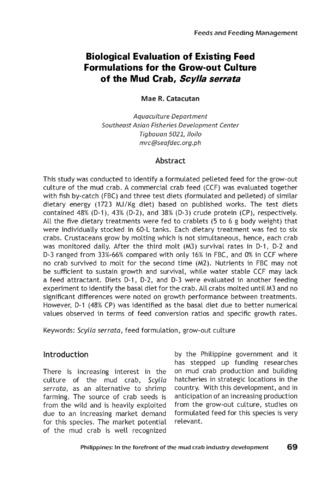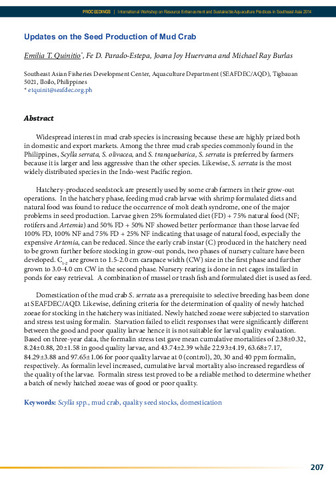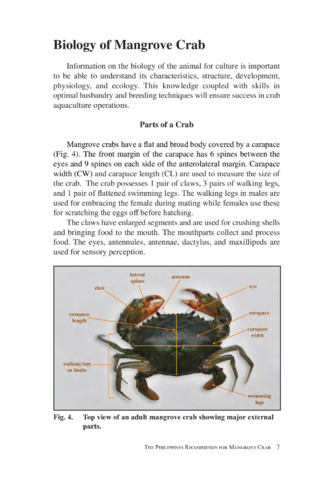Perlihatkan publikasi sederhana
Biological evaluation of existing feed formulations for the grow-out culture of the mud crab, Scylla serrata
| dc.contributor.author | Catacutan, Mae R. | |
| dc.contributor.editor | Quinitio, Emilia T. | |
| dc.contributor.editor | Parado-Estepa, Fe Dolores | |
| dc.contributor.editor | Coloso, Relicardo M. | |
| dc.date.accessioned | 2017-08-25T09:15:44Z | |
| dc.date.accessioned | 2017-08-25T16:37:39Z | |
| dc.date.available | 2017-08-25T09:15:44Z | |
| dc.date.available | 2017-08-25T16:37:39Z | |
| dc.date.issued | 2017 | |
| dc.identifier.citation | Catacutan, M. R. (2017). Biological evaluation of existing feed formulations for the grow-out culture of the mud crab, Scylla serrata. In E. T. Quinitio, F. D. Parado-Estepa, & R. M. Coloso (Eds.), Philippines : In the forefront of the mud crab industry development : proceedings of the 1st National Mud Crab Congress, 16-18 November 2015, Iloilo City, Philippines (pp. 69-76). Tigbauan, Iloilo, Philippines: Aquaculture Department, Southeast Asian Fisheries Development Center. | en |
| dc.identifier.isbn | 9789719931072 | |
| dc.identifier.uri | http://hdl.handle.net/10862/3201 | |
| dc.description.abstract | This study was conducted to identify a formulated pelleted feed for the grow-out culture of the mud crab. A commercial crab feed (CCF) was evaluated together with fish by-catch (FBC) and three test diets (formulated and pelleted) of similar dietary energy (1723 MJ/Kg diet) based on published works. The test diets contained 48% (D-1), 43% (D-2), and 38% (D-3) crude protein (CP), respectively. All the five dietary treatments were fed to crablets (5 to 6 g body weight) that were individually stocked in 60-L tanks. Each dietary treatment was fed to six crabs. Crustaceans grow by molting which is not simultaneous, hence, each crab was monitored daily. After the third molt (M3) survival rates in D-1, D-2 and D-3 ranged from 33%-66% compared with only 16% in FBC, and 0% in CCF where no crab survived to molt for the second time (M2). Nutrients in FBC may not be sufficient to sustain growth and survival, while water stable CCF may lack a feed attractant. Diets D-1, D-2, and D-3 were evaluated in another feeding experiment to identify the basal diet for the crab. All crabs molted until M3 and no significant differences were noted on growth performance between treatments. However, D-1 (48% CP) was identified as the basal diet due to better numerical values observed in terms of feed conversion ratios and specific growth rates. | en |
| dc.language.iso | en | en |
| dc.publisher | Aquaculture Department, Southeast Asian Fisheries Development Center | en |
| dc.subject | Scylla serrata | en |
| dc.subject | Philippines | en |
| dc.title | Biological evaluation of existing feed formulations for the grow-out culture of the mud crab, Scylla serrata | en |
| dc.type | Conference paper | en |
| dc.citation.spage | 69 | |
| dc.citation.epage | 76 | |
| dc.citation.conferenceTitle | Philippines : In the forefront of the mud crab industry development : proceedings of the 1st National Mud Crab Congress, 16-18 November 2015, Iloilo City, Philippines | en |
| dc.subject.asfa | aquaculture | en |
| dc.subject.asfa | crab culture | en |
| dc.subject.asfa | diet | en |
| dc.subject.asfa | feeds | en |
| dc.subject.asfa | feed efficiency | en |
| dc.subject.asfa | feeding experiments | en |
| dc.subject.asfa | growth rate | en |
| dc.subject.asfa | marine crustaceans | en |
| dc.subject.asfa | moulting | en |
| dc.subject.asfa | stocking density | en |
| dc.subject.asfa | survival | en |
| dc.subject.scientificName | Scylla serrata | en |
Files in this item
Publikasi ini ada di koleksi berikut
-
Philippines : In the forefront of the mud crab industry development [44]
Proceedings of the 1st National Mud Crab Congress






